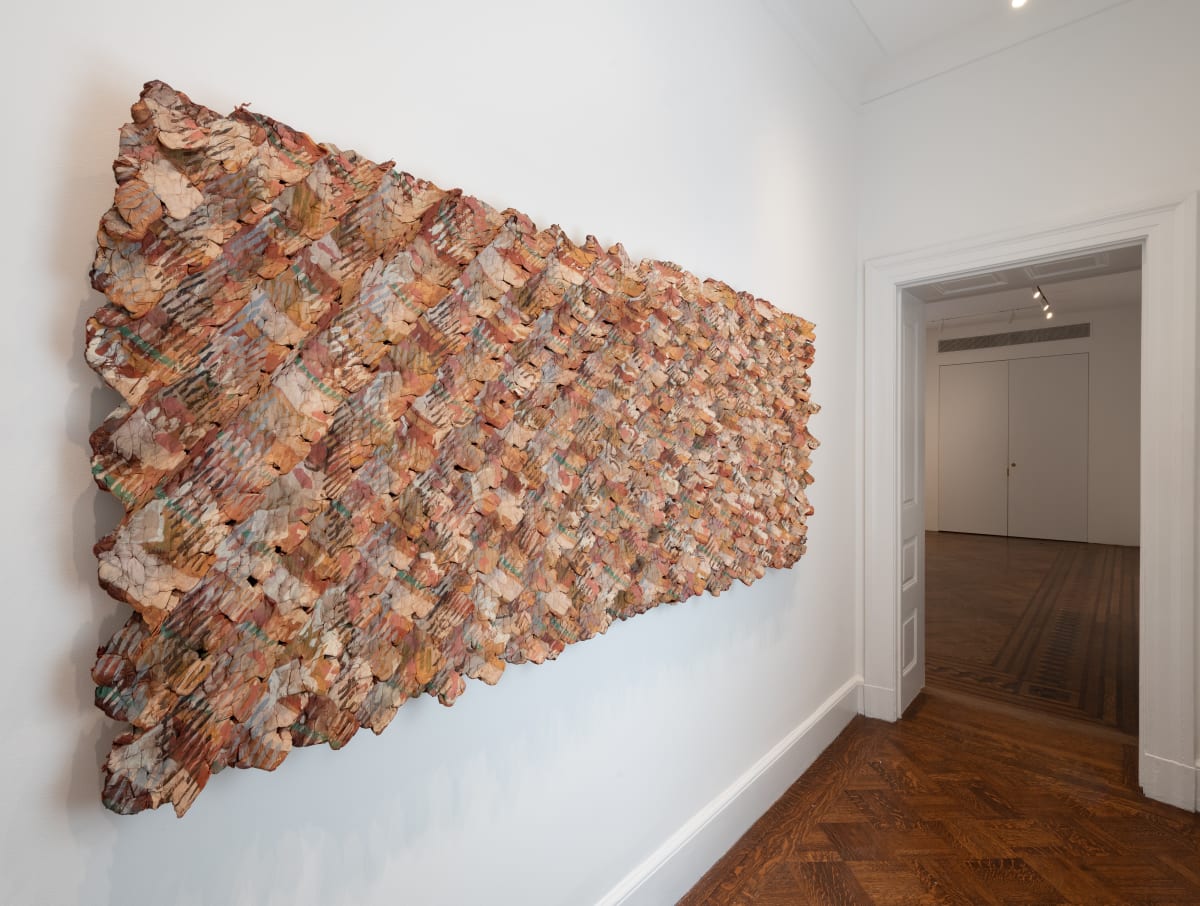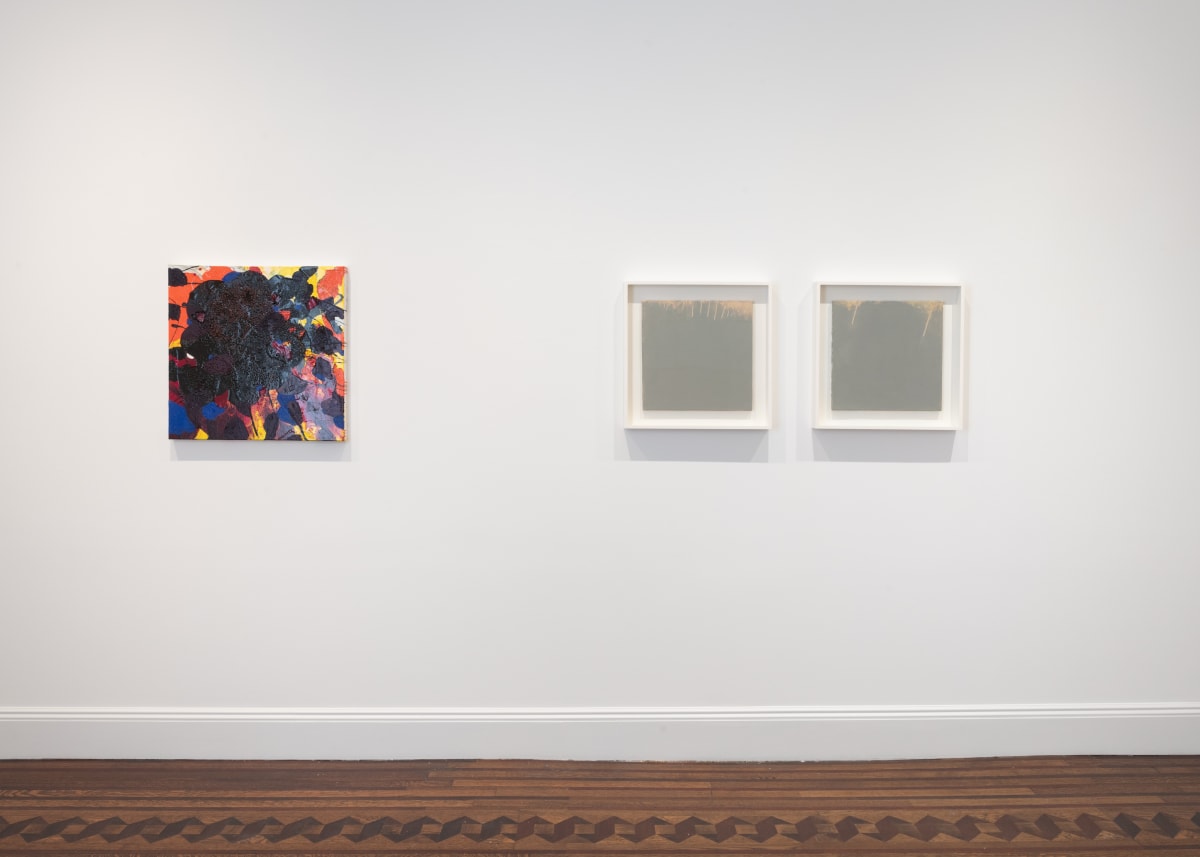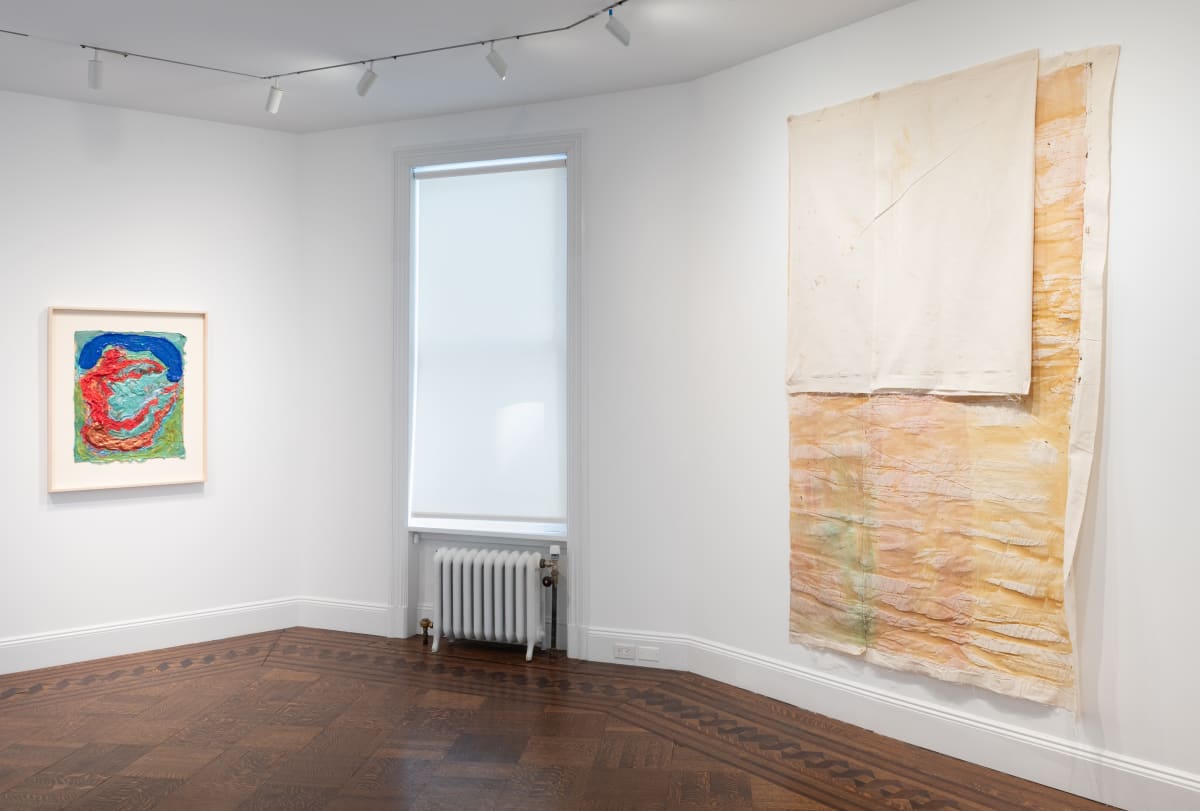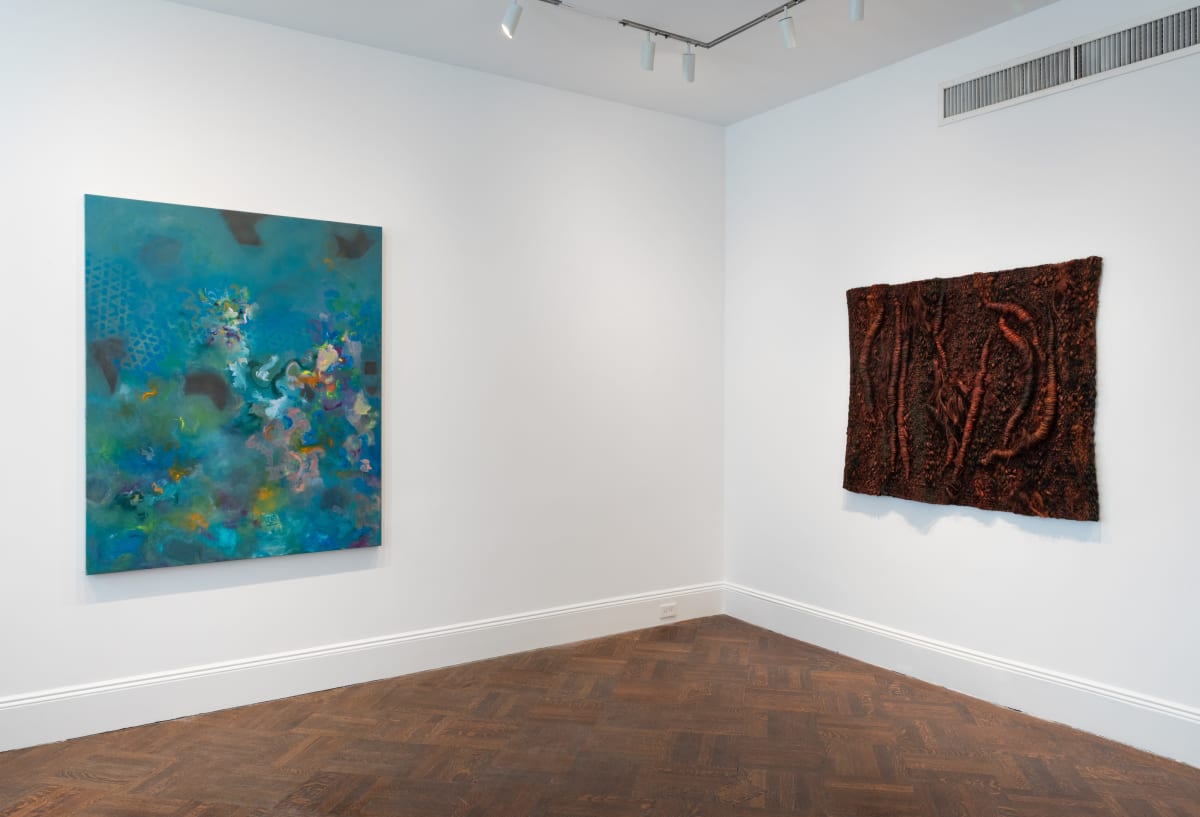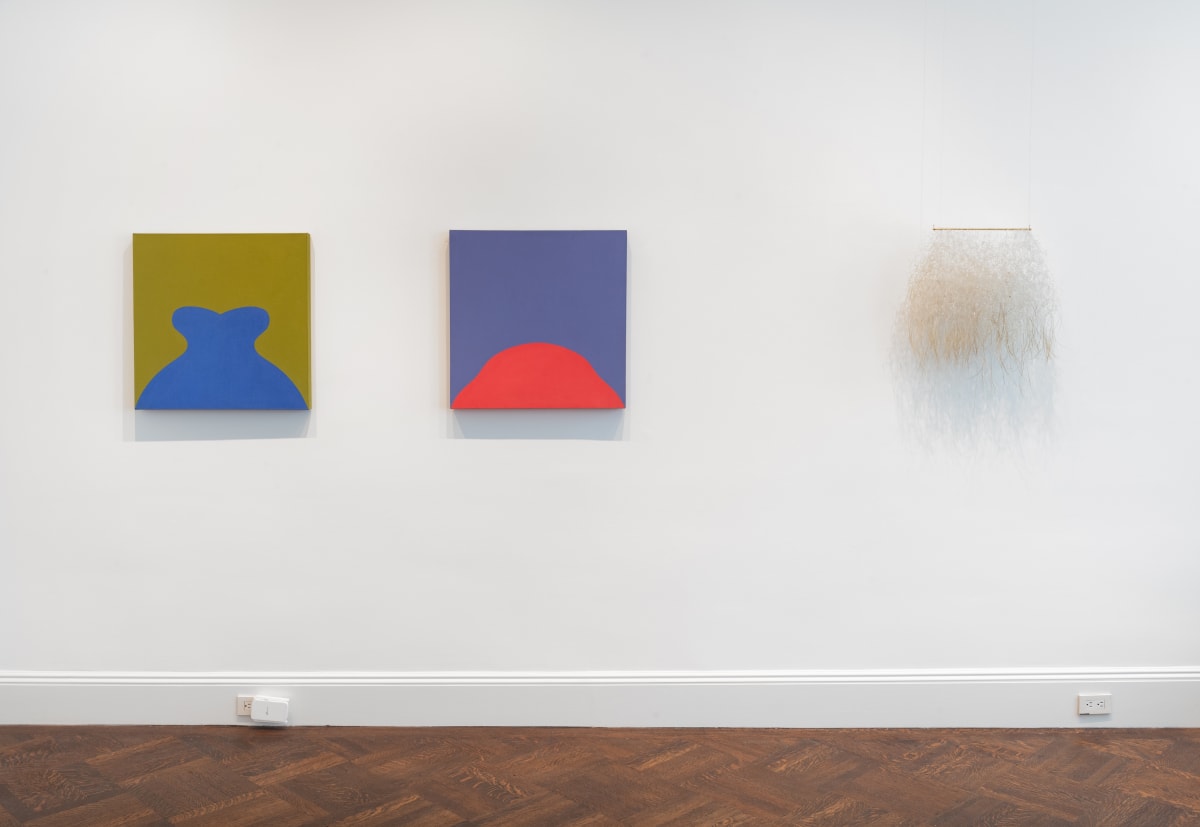Opening: Thursday, 11 July | 6pm
Richard Saltoun Gallery and Franklin Parrasch Gallery are pleased to present image-ridden impulse, a collaborative group exhibition of works by ten cross-generational artists working in the field of abstraction:
Magdalena ABAKANOWICZ (1930 - 2017), Latifa ALAJLAN (1998-), Yvonne Pacanovsky BOBROWICZ (1928 - 2022), Romany EVELEIGH (1934 - 2020), Marcia HAFIF (1929 - 2018), Neda AL HILALI (1938 -), Deborah REMINGTON (1930 - 2010), Sylvia SNOWDEN (1942-), Vivian SUTER (1949 -) and Tala WORRELL (1991-).
Magdalena Abakanowicz is regarded as one of the most influential Polish figures of the post-war period. A pioneering textile artist and major sculptor of the 20th century, she gained international recognition following her participation in the first Lausanne Tapestry Biennial in the 1960s. From this point onward, Abakanowicz began creating sculpture-like three-dimensional textiles. These spatial tapestries, which she termed “Abakans,” transformed traditional perceptions of tapestry and sculpture on a monumental scale, as seen in her recent solo exhibition at Tate Modern, London (2022/23). Relief Sombre de Stefa (1975) perfectly illustrates her work from this period, showcasing her signature palette of red, brown, and black. “I began using sisal and horsehair because I needed these materials to fully express my vision. I wasn’t bothered that they were not part of the tapestry tradition, as I have never been interested in its decorative function,” Abakanowicz stated.
Latifa Alajlan (b. 1998, Kuwait City, Kuwait) channels elements of Kuwaiti culture in her paintings through the use of patterning and form. Alajlan’s star-shaped canvases and latticework-like underpaintings reflect prevalent motifs in Middle Eastern architecture, including places of worship, government buildings, historical sites, and monuments. While Alajlan’s mode of abstraction is respective of the history of non-representative art in the Middle East, her expressive, atmospheric works represent a distinct and somatically evocative, conceptually driven practice. Flight-like gestures intermingle with identifiable idioms, calling systems of structure into question. Latifa Alajlan earned an M.F.A. in Painting and Drawing from the School of the Art Institute of Chicago in 2023, and a B.F.A. from the School of the Art Institute of Chicago in 2021.
Another pioneer of the Post-war fiber art movement, Yvonne Pacanovsky Bobrowicz, was similarly interested in the sculptural and architectural potential of textiles. Her Cosmic Series (2000) is a manifestation of the artist’s philosophical and spiritual reflections, embodying the universe's intricate balance of order and chaos. Influenced by the sensory and symbolic qualities of materials, Bobrowicz chose monofilament as the primary medium for this series for its translucency and ability to capture light. This choice was a significant shift from her earlier "earthy creations" to new, "cosmic ones."
The series integrates gold, revered by Bobrowicz as "the ultimate natural element," symbolizing spiritual perfection and cosmic energy. Her works weave together monofilament with linen and wool, creating dynamic sculptures that shimmer with light, reminiscent of energy fields and universal particles. The artist’s fascination with opposition and complementarity is evident in this work, as she blends natural and synthetic fibers, exploring contrasts and harmonies.
The exploration of contrast - of order and disorder, control and chaos - is present in the work of UK-born artist Romany Eveleigh, known for her abstract, minimalist paintings underpinned by a profound conceptual drive and interrogation of language and signs. A nomadic traveler for most of her life, Eveleigh settled in Rome with her wife, Anna Baldazzi, engaging actively with the radical lesbian movement in the 1970s. Their union with Baldazzi was one of the first same-sex marriages in Rome. A reclusive figure, Eveleigh worked on the margins of the art world, gaining significant recognition only in recent years, marked by her inclusion in this year’s Venice Biennial, curated by Adriano Pedrosa.
Her Oracle paintings (2017-18) are a quintessential example of her later series, characterized by a constant tension between free gesture and controlled mark making that evolves through constant repetition. “By expressing her longing for what she describes as the ‘sought-for beginning’ Eveleigh makes it clear that her work is about the making, rather than the end point”, describes art historian and curator, Flavia Frigeri. “The difficulty, or as she says ‘the magnitude of a beginning’ is challenging for the artist, who each time needs to find the energy to confront the empty surface that lies before her”.
Marcia Hafif’s (1929, Pomona, CA - 2018, Laguna Beach, CA) fifty-plus year long career spans so-called “Pop-Minimal” painting, experimental photography and filmmaking, and conceptually-driven monochromes and works on paper; central to her oeuvre is Hafif’s interest in pursuing a highly methodical approach which emphasizes the natural idiosyncrasies integral to the human touch. In 1978, Hafif penned an essay for Artforum titled “Beginning Again,” in which she outlined the struggle of the contemporary painter in an era when the act of painting had been (so many times already) deemed dead. In this piece, she cites Jacques Derrida’s phrase “under erasure” to describe the role of the painter - who many felt were left with little to divine in this already deeply mined practice - and points out the manner in which so many of her predecessors and contemporaries had found tension in this impossible state. It was at this time that Hafif committed to the monochrome approach for which she became most well known, and which she continued to explore and expand upon through the end of her life.
Hafif’s works have been exhibited extensively internationally; recent major exhibitions include An Extended Gray Scale at 5142 West Jefferson Boulevard (Los Angeles, CA), Marcia Hafif, The Inventory: Painting at Laguna Art Museum (Laguna Beach, CA), Marcia Hafif: The Italian Paintings 1961–69 and at Fergus McCaffrey (New York, NY). Hafif’s works can be found in the collections of the Museum of Modern Art (New York, NY), Buffalo AKG Art Museum (Buffalo, NY), and Art Institute of Chicago (Chicago, IL) among others.
Neda Al-Hilali is another defining figure amongst the trailblazing women artists working in large-scale three-dimensional fiber in the 1970s. Born in Czechia and raised in Baghdad, she moved to Southern California in 1961. Her artistic training, however, began in Europe and continued extensively at the University of California, Los Angeles, where she was immediately drawn to the sumptuous and symbolic qualities of fiber. Al-Hilali developed a systematic process of knotting, twisting, and plaiting threads into sculptures that subtly evoke myths and rituals. In the artist’s own words, her works are akin to "foot tracks of prolonged attention and energy," requiring many hours of intensive handiwork. Her work is currently featured in the exhibition Subversive, Skilled, Sublime: Fiber Art by Women at the Smithsonian American Art Museum (2024/25).
Deborah Remington (1930, Haddonfield, NJ - 2010, Moorestown, NJ), a renegade in every sense of the word and a relative of American West painter Frederic Remington, earned her B.F.A. in 1955 from the California School of Fine Arts (later renamed San Francisco Art Institute), where she studied with Clyfford Still, David Park, and Elmer Bischoff, amongst others. Her career burgeoned in the 1960s when she had three solo shows at the Dilexi Gallery in San Francisco and one at the San Francisco Museum of Art. In 1963, she was the only woman to show at Dilexi’s short-lived Los Angeles gallery alongside Joe Goode and H.C. Westermann. In New York, she exhibited at Bykert Gallery starting in 1967. A twenty-year retrospective exhibition of Remington’s work, curated by Paul Schimmel, was held at the Newport Harbor Art Museum (Newport Beach, CA) in 1983 (now Orange County Museum of Art), and traveled to the Oakland Museum of Art as well as several other venues. More recently, Remington’s work has been featured in several exhibitions including: Women of Abstract Expressionism, a traveling exhibition by the Denver Art Museum and Psychedelic: Optical and Visionary Art Since the 1960s, which opened at the San Antonio Museum of Art in 2010 and traveled widely. Remington was the recipient of numerous grants and awards in her lifetime including a Guggenheim Fellowship (1984), a National Endowment for the Arts Fellowship (1979), and a Tamarind Fellowship (1973), among others. In 1999, she was elected to the National Academy of Design and received a Pollock-Krasner Foundation Grant.
Sylvia Snowden’s (b. 1942, Raleigh, NC) command of chromatic range, from dark and earthy tones to the vibrant and artificial, is the fuel of her expressionistic style. The voluminous figures Snowden depicts, often contrapposto, are surrounded by peaks of shifting chroma in a physical manifestation of feeling: the tensions and intensity of life, and the troubled, optimistic, and dramatic elements of our sublime existence. Snowden’s works encapsulate the psychological essence of her subjects – some of whom she knew only in passing, others with whom she had intimate or long-term relationships – and in her works their triumphs, paranoia, agony, and anger are all laid bare. Sylvia Snowden holds both B.A. and M.A. degrees from Howard University (Washington, DC), earned in 1963 and 1965 respectively, where she studied with David C. Driskell and Lois Maillou Jones. In 1962, Snowden traveled to France with a cohort of fellow Howard University art students and earned a certificate of completion from Académie de la Grande Chaumière (Paris, FR). Later, in 1964, Snowden received a scholarship to attend Skowhegan School of Painting and Sculpture (Skowhegan, ME). Snowden has taught at Cornell
University (Ithaca, NY), Howard University (Washington, DC), and Yale University (New Haven, CT), and has served as an artist-in-residence, a panelist, visiting artist, lecturer/instructor, and curator in universities, galleries, and art schools in the United States and internationally.
After a successful but brief career as a young painter in Basel, Swiss artist Vivian Suter withdrew from the conventional art world, embarking on an introspective journey through California and Central America. Her travels eventually led her to the vibrant environs of Panajachel, Guatemala. Here, immersed in the lush flora and fauna, Suter's abstract forms began a profound engagement with nature. Inspired by the tropical habitat's verdant plants, vivid flowers, and dynamic weather, her mixed media abstract paintings capture the forest's living energy. These large, unstretched canvases, such as the work Untitled (2000s) in the exhibition, are imbued with rich color, gestural brushstrokes, and organic motifs, creating works that resonate with the natural world's inherent vitality.
Tala Worrell (b. 1991, New York, NY) was born in New York City and raised in Abu Dhabi. Worrell’s cultural exposure as a Lebanese-American woman raised in the United Arab Emirates is steeped in diverse sets of values; prevailing is the necessity of acceptance and openness to conflicting ways of understanding. Through this lens, Worrell’s approach to abstraction is distilled in the belief that every aesthetic decision involves the resolution of ethical dilemmas. In her democratic use of materials – oils, alkyds, and industrial paints are as valuable as less common media like za’atar, chia seeds, and sesame seeds – Worrell poignantly reflects on her multivalent background. Dichotomies fuel Worrell’s work, which involves wide-ranging experimental processes, and she employs tensions in the contrasts of surfaces, material choices, and chromatic decisions to her advantage as she considers and processes quotidian physical and visual encounters. In her works, Worrell deftly navigates the chasm between her familial and cultural roots and her Western education. In 2014-15, Worrell was a Fellow at the 10 month-long Ashkal Alwan Home Workspace Program (Beirut, Lebanon) where she worked with resident professors Kader Attia, Walid Raad, and Joana Hadjithomas and Khalil Joreige, among others; in 2015-16, she was the recipient of a nine-month-long Emerging Artists Fellowship at the Salama bint Hamdan Foundation (Abu Dhabi, UAE) established in partnership with Rhode Island School of Design; and a residency at the Abu Dhabi Cultural Foundation in 2020. Worrell worked as a researcher and painting assistant for painter and filmmaker Sarah Morris from 2014-19. Worrell’s works have been exhibited at Sfeir-Semler Gallery (Hamburg and Beirut), Beirut Art Center (Lebanon) and Warehouse 421 (Abu Dhabi, UAE). Worrell lives and works in Los Angeles.
![Magdalena Abakanowicz, Relief sombre de Stefa [Dark relief of Stefa], 1975.](https://artlogic-res.cloudinary.com/w_500,h_500,c_limit,f_auto,fl_lossy,q_auto/ws-richardsaltoun2/usr/images/exhibitions/group_images_override/127/mak005-image.jpg)
